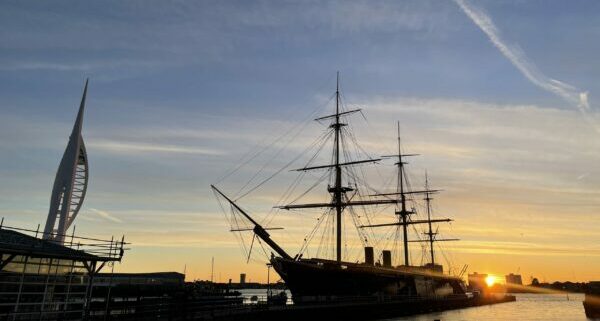
HMS Warrior made history in 1860 as the world’s first iron-hulled, armoured warship, marking a revolutionary shift globally from wooden ships to ironclads.
Built by the Thames Ironworks and Shipbuilding Company, Warrior’s design combined iron armour over a wooden frame, offering unprecedented durability and protection. She reached speeds of up to 14.5 knots, powered by both steam engines and traditional sails that allowed her to cover great distances efficiently.
HMS Warrior measured 380 feet in length, weighed 9,210 tons, and stood as the largest, fastest, most advanced warship of her time.
Although HMS Warrior never saw battle, her advanced technology was a strong deterrent and credited for the rapid advancement in warship design that followed her launch.
She was decommissioned in 1883, where she went on to become a reserve vessel. From 1929-1979, the vessel was converted into a floating oil jetty in Pembroke Dock, Wales. In 1979, Warrior was restored back to her 1860 condition and brought to Portsmouth, where she now serves as a museum ship.

Historic ships such as Warrior rarely undergo inspections and drydocking as regularly as modern ships, leaving the condition of some areas largely unknown.
HMS Warrior was last drydocked over 20 years ago. The National Museum of the Royal Navy needed more information to determine the feasibility of future drydocking and a plan outlining the steps such a task would require.
Beckett Rankine carried out a detailed survey of the vessel, including confined space inspections. We drafted a full specification for drydocking that outlined the budget and timeline – accounting for minimal downtime for the museum – plus a plan for safe maintenance processes.
As a result, the project evolved into a five-year plan with a programme of remedial internal and structural works.
Difficulties accessing some areas of the ship meant they had not been inspected for decades, due to thousands of tonnes of iron blocks used as ballasts that were likely installed during the 1980s restoration.
With some compartments filled from floor to ceiling with these blocks, the inspection identified for the first time the exact quantity and location of them all.
Thankfully, Beckett Rankine has faced a similar problem before. Drawing inspiration from a similar system used on Glenlee, we have designed a system that would allow moving the iron between Warrior’s compartments without compromising the ship’s stability while work is carried out on the hull.
Like many historic vessels, HMS Warrior’s internal layout is not easily accessible in all areas. Some compartments are accessed through narrow openings less than a metre wide, requiring confined space inspections due to the risk posed by potential low oxygen levels in the compartments.
Beckett Rankine’s team includes engineers trained in confined space inspections, ensuring safe and thorough checks. Each compartment is gas monitored, and a specialist team trained in evacuation procedures is on standby.
Where access is too narrow to safely enter, technology can provide safer methods of assessing and treating any issues. Inspections are performed with cameras while anti-corrosion treatment can be deployed using vapour and dehumidifying systems.